![]()
NOTEWORTHY ELEMENTS OF THE FLORA
The Ketona Glade habitat exhibits an islandlike distribution, mostly in a single broad arc, with a region near the center of the arc where the outcrops are more numerous and where all of the larger glades occur. Species richness of sites corresponds well to models of island biogeography. All of the endemic and characteristic species can be found in the core area, and three of the endemic taxa are restricted to it. In general, the larger the glade, the greater the diversity of taxa it supports. An anomaly is Astrolepis integerrima (Hook.) Benham & Windham, which we found on none of the largest glades, but instead only on one moderate-sized and one small glade.
The Alabama Natural Heritage Program (ALNHP) maintains a database of information about plants, animals, and natural communities of Alabama, with an emphasis on those that are threatened with severe decline. Such threatened elements of biological diversity are "tracked," meaning that known occurrences are individually mapped and described in the ALNHP database. As we explored Bibb County habitats, we were continually surprised by new additions to the list of ALNHP-tracked elements found in the county. By 1995, we had recorded and reported to ALNHP a total of well over 600 individual rare(2) vascular plant element occurrences, representing a diverse array of taxa of conservation concern. Once incorporated into the ALNHP database, this information was used to set priorities for protection of sites critical to the conservation of this concentration of rare species. Results to date of protection efforts are discussed near the end of the body of this paper, under "Conservation Status."
Eight new endemic taxa, all found during our initial field season (1992), are the most distinctive
elements of the flora. Two of these, an Onosmodium (Boraginaceae) and a perennial variety of
Erigeron strigosus (Asteraceae), are strongly characteristic of Ketona Glades, abundant at virtually
every site. A well marked variety of Coreopsis grandiflora (Asteraceae) and a somewhat
inconspicuous species of Dalea (Fabaceae) are also frequent, but neither reaches the glades near the
western periphery of the Ketona Glade region. Near the center of this region, where the glades are
most numerous and achieve their greatest areal extent (and the flora is best developed), all of these
are joined by an endemic variety of Spigelia gentianoides (Loganiaceae), and a new, yellow-flowered
species of Castilleja (Scrophulariaceae). On the glades in the very heart of the region, nested within
the area where the ranges of all the others overlap, we found the rarest and most distinctive of the
new taxa, a remarkable species of Liatris (Asteraceae). Finally, we found one Bibb County endemic
whose range extends slightly beyond the Ketona Glades proper: an odd, densely glandular Silphium
(Asteraceae), which occurs on the majority of Ketona Glades and also in rocky areas along Bibb
County streams, where it grows over dolomite or limestone.
Comparison of these undescribed taxa with their putative nearest relatives, in the herbarium and
in the field, led the first author to the conclusion that the theoretically closest relatives
of both the new
Silphium species and of the new variety of Erigeron strigosus were themselves previously
unrecognized taxa in need of description. Their formal description is effected herein, so that the
Ketona Glade endemics may be placed in their full systematic context. Supplementary information
about these non-Ketona Glade taxa as well as color imagery of the Bibb County endemics can be
found on the senior author's Web page (http://www.mindspring.com/~jallison/).
* * *
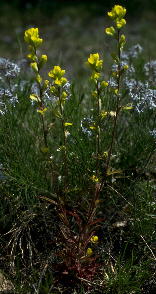 Next to the new Liatris and Spigelia L., a yellow-flowered Castilleja has the most restricted
range of the Bibb County Ketona Glade endemics, found only on the glades near the Little Cahaba
River and on one a little east of the Cahaba River.
Next to the new Liatris and Spigelia L., a yellow-flowered Castilleja has the most restricted
range of the Bibb County Ketona Glade endemics, found only on the glades near the Little Cahaba
River and on one a little east of the Cahaba River.
It is a pleasure to be able to name a plant for Robert Kral of Vanderbilt University, in recognition of his many significant contributions to the botany of the southeastern states and to the taxonomy of some very difficult groups.
Castilleja kraliana J. Allison, sp. nov. TYPE: Alabama: Bibb County, ca. 15.7 km NE of Centreville, ca. 0.6 km NW of Bulldog Bend Bridge. "Bulldog Glade," Ketona Dolomite outcrop ca. 0.6 km N of the Little Cahaba River, 15 Apr 1998, James R. Allison 10466 (holotype, NY; isotypes: AUA, BRIT, GA, GH, JSU, MICH, MO, TENN, UNA, US, VDB). Figure 3.
Inter species sectionis Euchromae (Nutt.) Benth. sensu Pennellii (Pennell 1935), rosula sub anthesi plerumque persistenti et foliis non infrequenter lobatis ad C. coccineam (L.) Spreng. accedens sed calycibus brevioribus (ad 1.8 cm longis) et bracteis brevioribus (ad 2.1 cm longis) nunquam rubris generatim integris ab illa recedens.
Annual or biennial herb, (1.6) 2-4 (4.9) dm tall from a basal rosette that usually persists into
anthesis. Stems 1-several, erect, simple or few-branched, purple, gray-purple or brown, sulcate,
especially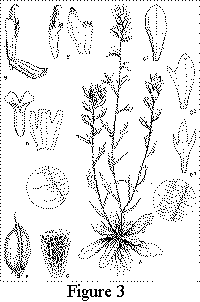 upward, with an indument of short, glandular hairs and long, spreading, jointed, mostly
eglandular hairs, becoming denser towards the inflorescence, more or less glabrescent below. Leaves
with indument like that of the stem, especially along the margins and the conspicuous veins, the basal
ones green or more often suffused to varying degrees with red, oblanceolate to obovate, 2-6 cm long,
(0.6) 0.8-1.2 (4.3) cm wide, entire or sometimes with 1 or 2 rather small (to 4.5 mm long) lateral
lobes, apices obtuse to broadly rounded or occasional extremes acute or subtruncate, the cauline ones
mostly (3) 6-10 (12), normally green but sometimes the lower suffused with red, 1.1-6.5 cm long
and 0.2-2.2 (2.6) cm wide, linear to
upward, with an indument of short, glandular hairs and long, spreading, jointed, mostly
eglandular hairs, becoming denser towards the inflorescence, more or less glabrescent below. Leaves
with indument like that of the stem, especially along the margins and the conspicuous veins, the basal
ones green or more often suffused to varying degrees with red, oblanceolate to obovate, 2-6 cm long,
(0.6) 0.8-1.2 (4.3) cm wide, entire or sometimes with 1 or 2 rather small (to 4.5 mm long) lateral
lobes, apices obtuse to broadly rounded or occasional extremes acute or subtruncate, the cauline ones
mostly (3) 6-10 (12), normally green but sometimes the lower suffused with red, 1.1-6.5 cm long
and 0.2-2.2 (2.6) cm wide, linear to 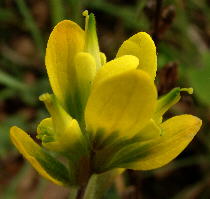 linear-lanceolate or -oblanceolate or rarely elliptic, the lowest
sometimes obovate, entire or with 1-4 (5) narrow, lateral lobes to 1.8 cm long, usually acute at the
apex, occasionally with an axillary fascicle of greatly reduced leaves. Inflorescence racemose, (2.2)
4-18.5 (24) cm long, dense and short at first, loosening and lengthening with age, most of the
coloration coming from the bracts and calyx segments. Flowers nearly sessile, on pedicels at most
about 1.5 mm long; bracts at anthesis shorter and broader than the upper leaves, obovate or less often
oblanceolate, 1.1-2.1 cm long, entire or sometimes with 1 or 2 lateral lobes to 3 mm long, broadly
rounded at apex, yellow (rarely orange) throughout or yellow (orange) distally and otherwise green,
pubescent proximally, ciliate with long and short hairs proximally and with short hairs distally, after
anthesis becoming more leaflike (becoming greener, lengthening to as much as 2.8 cm, lateral lobes,
when present, particularly accrescent, to 7 or even 10 mm long); calyx (1.3) 1.5-1.8 cm long, slightly
longer than to distinctly shorter than the lower lip of the corolla, the abaxial cleft 5.7-7.0 mm deep,
the slightly shallower adaxial cleft 5.0-6.5 mm deep, the fused portion green and the lobes pigmented
like the bract apices, proximally with spreading, short and long, glandular and pointed hairs, the clefts
ciliate, the cilia longer proximally, shorter distally and becoming minute on the apices; corolla (1.5)
1.7-2.3 cm long, yellowish green or often the galea margins and sometimes the teeth of the lower lip
yellow; upper lip (galea) (5.2) 6-7 mm long, straight, exceeding the lower lip by about 5 mm, distally
puberulent, proximally at least the keel and usually also the veins puberulent, lower lip slightly
inflated, eciliate, the lateral teeth 0.7-1.9 mm long, the central tooth 0.5-1.3 mm long; stamens 4,
each with 2 anther-sacs, the larger 1.0-1.2 mm long, the smaller 0.8-1.0 mm long; style light
yellowish green, the
linear-lanceolate or -oblanceolate or rarely elliptic, the lowest
sometimes obovate, entire or with 1-4 (5) narrow, lateral lobes to 1.8 cm long, usually acute at the
apex, occasionally with an axillary fascicle of greatly reduced leaves. Inflorescence racemose, (2.2)
4-18.5 (24) cm long, dense and short at first, loosening and lengthening with age, most of the
coloration coming from the bracts and calyx segments. Flowers nearly sessile, on pedicels at most
about 1.5 mm long; bracts at anthesis shorter and broader than the upper leaves, obovate or less often
oblanceolate, 1.1-2.1 cm long, entire or sometimes with 1 or 2 lateral lobes to 3 mm long, broadly
rounded at apex, yellow (rarely orange) throughout or yellow (orange) distally and otherwise green,
pubescent proximally, ciliate with long and short hairs proximally and with short hairs distally, after
anthesis becoming more leaflike (becoming greener, lengthening to as much as 2.8 cm, lateral lobes,
when present, particularly accrescent, to 7 or even 10 mm long); calyx (1.3) 1.5-1.8 cm long, slightly
longer than to distinctly shorter than the lower lip of the corolla, the abaxial cleft 5.7-7.0 mm deep,
the slightly shallower adaxial cleft 5.0-6.5 mm deep, the fused portion green and the lobes pigmented
like the bract apices, proximally with spreading, short and long, glandular and pointed hairs, the clefts
ciliate, the cilia longer proximally, shorter distally and becoming minute on the apices; corolla (1.5)
1.7-2.3 cm long, yellowish green or often the galea margins and sometimes the teeth of the lower lip
yellow; upper lip (galea) (5.2) 6-7 mm long, straight, exceeding the lower lip by about 5 mm, distally
puberulent, proximally at least the keel and usually also the veins puberulent, lower lip slightly
inflated, eciliate, the lateral teeth 0.7-1.9 mm long, the central tooth 0.5-1.3 mm long; stamens 4,
each with 2 anther-sacs, the larger 1.0-1.2 mm long, the smaller 0.8-1.0 mm long; style light
yellowish green, the stigma capitate, bilobed, exserted (0.4) 1.8-4 (7) mm beyond the upper lip. Fruit
a somewhat obliquely ellipsoid to narrowly obovoid capsule, (0.75) 1.1-1.2 cm long, the apex short-beaked; seeds
numerous in each capsule, 1-1.4 (1.6) mm long, yellowish, the seed coat deeply
reticulate with (7) 8-10 (12) cells in each longitudinal row. Chromosome number unknown.
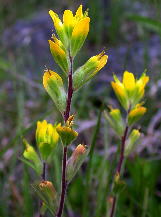
Flowering (March) April-June (July), a single plant seen in flower in mid-November, fruiting late April-July.
English Name: Cahaba Paintbrush.(3)
Paratypes. Alabama: Bibb Co., (topotype) 1 May 1993, A. and S. 7575(4) (AUA, DUKE, FLAS, JSU, UNA, USCH); 12.5 km NNE of Centreville, "Eastside Glade," 2 May 1993, A. and S. 7584 (GA, GH, MICH, MO, NY, UNA, US); 13.6 km NE of Centreville, "Double Glade South," 26 Apr 1993, A. and S. 7559 (AUA, DUKE, JSU, TAMU, UNA); 14.0 km NE of Centreville, "Starblaze Glade Southwest," 26 Apr 1993, A. and S. 7555 (AUA, GA, GH, MICH, MO, NY, UNA, US, VDB); 14.6 km NE of Centreville, "Goat Glade South," 14 Jun 1992, A. and S. 6725 (AUA, UNA); 14.9 km NE of Centreville, "Goat Glade North," 26 Apr 1993, A. and S. 7549 (GA, NY, US); 15.1 km NE of Centreville, "Pinkroot Glade West," 25 Apr 1993, A. and S. 7545 (GH, JSU, MO).
Castilleja kraliana usually grows in full sun, occasionally in partial shade at the edges of glades or of wooded islands within them.
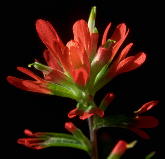 The calyx morphology of Castilleja kraliana indicates a close relationship to C. coccinea (L.)
Spreng. It differs most importantly by its bracts, which are
The calyx morphology of Castilleja kraliana indicates a close relationship to C. coccinea (L.)
Spreng. It differs most importantly by its bracts, which are![Pressed inflorescences of Castilleja. Four stems of the smaller-flowered C. kraliana flanked by one each of yellow- and red-flowered C. coccinea. L-R [all US]: A. 10478, Izard Co., Ark., 19 Apr 1999; A. 10466, Bibb Co., Ala., 15 Apr 1999; A. 8270, Lumpkin Co., Ga., 8 May 1994.](cast2spp_small.jpg) mostly entire, bright yellow and at most
about 2 cm long. In C. coccinea the bracts are deeply lobed, red or rarely yellow, and mostly more
than 2 cm long. The latter's calyx and corolla also average larger than in C. kraliana, though there
is overlap in the ranges (due to a reduction of flower size late in anthesis in C. coccinea).
mostly entire, bright yellow and at most
about 2 cm long. In C. coccinea the bracts are deeply lobed, red or rarely yellow, and mostly more
than 2 cm long. The latter's calyx and corolla also average larger than in C. kraliana, though there
is overlap in the ranges (due to a reduction of flower size late in anthesis in C. coccinea).
We have observed one population of Castilleja coccinea composed entirely of
yellow-flowered
plants, on a glade in Izard County, Arkansas (A. and S. 8877, UARK; A. 10478, DUKE, GA, GH,
MICH, MO, NY, UARK, US; A. 10859, UARK). These plants, with larger flowers than C. kraliana
and with consistently deeply lobed bracts, appeared to differ only in bract and calyx coloration from
red-flowered plants of C. coccinea. Like C. kraliana, these yellow-flowered plants produced a red
pigment, normally evident only in the rosette leaves. In neither case, therefore, would it seem that the
yellow coloration of the inflorescence is due to 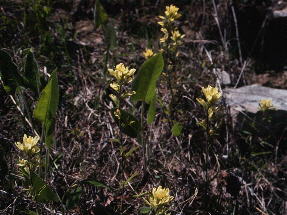 a mutation interfering with the production of red
pigment. Rather, the red pigment normally so characteristic of C. coccinea has been sequestered in
the rosettes and sometimes the lower leaves of these plants.
a mutation interfering with the production of red
pigment. Rather, the red pigment normally so characteristic of C. coccinea has been sequestered in
the rosettes and sometimes the lower leaves of these plants.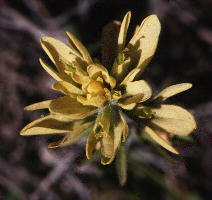
The divergence between Castilleja kraliana and C. coccinea is apparently related to a difference in pollinators, with red-flowered C. coccinea pollinated by hummingbirds, while C. kraliana, as is usual with yellow-flowered Castilleja, is pollinated by bees (Chuang and Heckard 1991, Duffield 1972). Indeed, we saw and photographed a (putative) Bombus sp. "working" the flowers of C. kraliana. Presumably, C. kraliana is derived from C. coccinea, with the divergence due to a shift in pollinators, though the reverse could instead be true. According to label data seen in several herbaria, additional entirely yellow-flowered populations, referred to C. coccinea, are known. It would be a useful project, never more feasible than it is today, to ascertain whether these populations are all genetically more closely related to each other, or whether a shift in pollinators has occurred repeatedly in that species and some yellow-flowered populations are more closely related to red-flowered populations of the same region than to other, more distant, yellow-flowered ones.
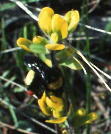 The change in pollen vectors (whatever the direction) has been accompanied by significantly
more morphological divergence from typical Castilleja coccinea in
The change in pollen vectors (whatever the direction) has been accompanied by significantly
more morphological divergence from typical Castilleja coccinea in the Bibb County plants than in
the yellow flowered populations referable to C. coccinea, and thus the Bibb County plant is afforded
species status here. The two species also appear to be allopatric, with the nearest known population
of C. coccinea two counties to the east (a Coosa County specimen at AUA).
At the westernmost glade where Castilleja kraliana occurs, "Eastside Glade" (about 0.3 km east of the Cahaba River), we found that some of the plants had bracts and calyces orangish-tinged, and that some had slightly more deeply lobed bracts than is usual for the species. The single population under discussion is not only the westernmost population but is also the most geographically isolated population (about 2.2 km from the nearest of the other populations, while none of the latter is more than 0.6 km from another population). Perhaps one or more undetected populations of the widespread C. coccinea occur or occurred within the valley of the Cahaba River, and a past hybridization event resulted in the infusion of some C. coccinea alleles into the comparatively isolated population of C. kraliana closest to the river. Another hypothesis is that C. coccinea was once an element of the flora of the Ketona Glades, and the process of its replacement by C. kraliana is virtually, but not absolutely, complete.